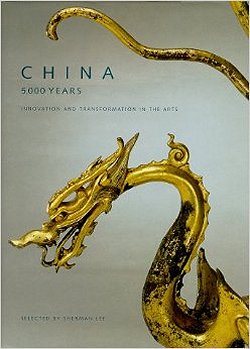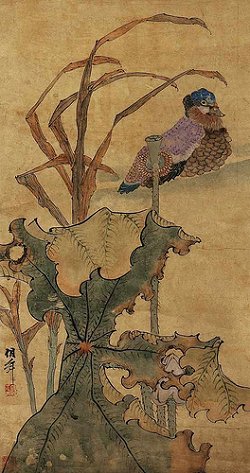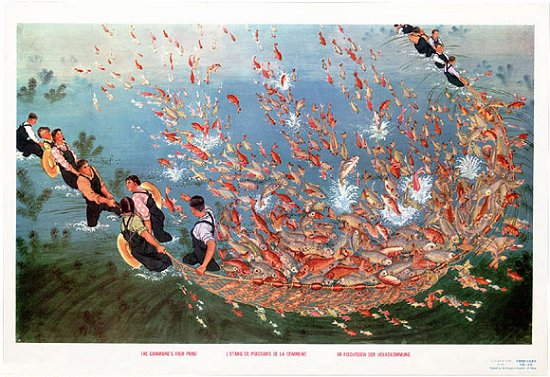
It isn’t easy to mount a terrible show in which each piece of art is absolutely fantastic. But until one has confronted the reality of “China: 5,000 Years,” one cannot imagine either how good the material or how bad every curatorial decision (assuming that there were some curatorial decisions) could be. There are some successes here: the museum staff have done an able job, for example, with the lighting of the show; and no fair-minded review could skip mention of the handsome display cases made specifically for the exhibition. It’s a shame, though, that “China: 5,000 Years” is incoherent, misleading, patronizing of the culture it ostensibly celebrates, politically expedient, and hypocritical.
To understand the context of the Guggenheim‘s survey, one must go back a couple of years to another exhibition. In 1996, after a decade of planning, the Metropolitan Museum of Art opened an exhibition of work from the National Palace Museum in Taiwan. The Palace Museum’s holdings are essentially the collection of the Chinese emperors, and Wen Fong, consultative chairman of the Department of Asian Art at the Met, did an extraordinary job of both representing the collection qua collection and selecting the very best art. Despite the last-minute withdrawal of several important pieces, the show was both intelligent and very, very beautiful.
The fact that it also served the purposes of the Republic of China government did nothing to mitigate Fong’s achievement. Indeed, it served the purposes of the ROC so well precisely because it was such a good show. The Mainland was much annoyed by the success of the exhibition. Chiang Kai-shek’s successful abduction of the Imperial collections has been a thorn in the side of the Communists since 1949. Mainland authorities, determined not to be outdone, made it clear that they would be receptive to a counter-exhibition on the scale of the Met’s show, and the Guggenheim rushed in where angels might have feared to tread. Hence “China: 5,000 Years.” The Guggenheim was at a distinct disadvantage from the start. Whereas the Met’s exhibition had relied on a specific group of works that had been incorporated by the Ch’ien-lung emperor into a strictly hierarchical canon, the Guggenheim’s show was to be curator Sherman Lee‘s selection of whatever good stuff could be found around the Mainland. Wen Fong had a specific if conservative vision and objective: he believed in the Imperial notion that literati painting is the highest form of art, in the dominion of the Song dynasty (tenth to thirteenth centuries) and the monumental landscape, and in other traditional structures of Chinese art history. The Guggenheim show, on the other hand, has no shadow of an objective. It’s a rich grab bag, in which tomb objects and clay figures and court painting and calligraphy are all displayed helter-skelter, as though the curators had gone on a wild spree and come home, dumped their full shopping bags, and spread out the contents for a momentary glut of materialist ecstasy.
Imagine a show, mounted in Shanghai, called “The History of Western Art.” Imagine that every single piece of art in this show were of the highest possible standard, that the show included things that had never before traveled to Asia. In the first room, there might be some cave paintings from Lascaux, a fragment of a Pompeiian fresco, and an illuminated book of hours. The next room would tell the story of the Renaissance with one Masaccio, one minor work by Fra Filippo, two spectacular Bronzinos, a room of Durer drawings, a fine Van Eyck, and The Birth of Venus. Then there would be a few rooms of usable objects, say, a number of iron age tools, three pieces of Mycenaean gold, a bunch of Roman coins, and some magnificent Russian empire furniture. The next room might be sculpture, with one Greek figure attributed to Praxiteles, a number of extremely good Assyrian reliefs, and Michelangelo’s David. It would be hard to fault such an exhibition on content, and for someone well-versed in Western art it would be rather exciting to see so many great things gathered in one place. But for anyone trying to understand the work of an unknown culture, the show’s incoherence would matter a lot.
At an opening event for “China: 5,000 Years,” Thomas Krens acknowledged that it was unusual for his museum to stage a show of such old art. “There is an explanation for our decision to do it,” he said, “and that is just one five-letter word.” C.H.I.N.A. was the word. It sounded rhetorically grand, but it was hard to see how that five-letter word carried more weight than, say, “I.T.A.L.Y.” or “E.G.Y.P.T.,” except that the government of “C.H.I.N.A.” happened to see a political purpose in getting this in a major U.S. museum; and, at a time when Mr. Krens has perhaps “O.V.E.R.R.E.A.C.H.E.D.” himself in general, it was very convenient to have such ready access to great art.
The downtown exhibition of more recent art was unsuccessful for quite different reasons. The show was originally supposed to include both “traditionalist” work of the late nineteenth and twentieth centuries and “nontraditionalist” art. The latter was canceled shortly before the opening. (Though the museum says the problem was money, consulting curators have been accused of having personal interests in the display of certain artists, and others have alleged that the Mainland government may have threatened to withhold loans of older material if more radical recent work had been included.) Regardless of which explanation one accepts, the result is an exhibition that presents one side of a complicated story. It is not incoherent; indeed it is a streamlined and excellent display of what it does include. And there is no reason, really, why a show of this material alone is not valid. But there is plenty of reason why it should, in its wall labels, its catalogues, and its arrangement, acknowledge the existence of what it does not include; and it should not under any circumstances act like it is the art of Modern China. Imagine, in the last section of our Shanghai show of Western art, rooms full of realist landscapes, including everyone from Frederic Church to Edward Hopper to Norman Rockwell to Winslow Homer, and you’ll have the idea.

Painting by Ren Yi (1840-1896)
Downstairs at the Guggenheim SoHo, we get the late nineteenth century. Much of the work shown here is political in content, though you’d certainly never know it from these displays. Much of it has subtly absorbed Western influence. Look at the eye of the bird in Ren Yi‘s marvelous album. Content that might once have been expressed in formal metaphors is now psychologized: the bird looks suspicious, anxious, and attentive, as was the whole of the intelligentsia toward the end of the Qing dynasty. This psychologizing tendency, especially when applied to the portrayal of a creature whose eyes do not in real life convey emotion, is absolutely Western. This painting makes it in under the Guggenheim’s “traditionalist” rubric, but though the artist is using a brush and ink, what he is doing is much more innovative than the work of contemporaneous Chinese painters who were dabbling in oils. It is simply misleading to make traditionalism a matter of media in this context.
Upstairs, there is a display of twentieth-century work that is once more called “traditionalist” because much of it is done with brush and ink. The underground art world of the post-Cultural Revolution period, as well as the artists involved in the Democracy Wall movement, is hardly mentioned. The work on the second floor is, by and large, propaganda work of the Cultural Revolution, some of it the best examples from the period, including images I’ve seen reproduced a thousand times. But the Gug doesn’t do much to acknowledge that this is propaganda work, and propaganda for a pretty dubious movement (72 million people killed) at that.
Some of the accompanying wall labels would not have seemed out of place in a provincial city hall in Shaanxi Province in 1979. Beside a painting of some beaming young people in Mao suits, for example, there is this explanation: “Between 1968 and the end of the Cultural Revolution, all of China’s middle school graduates were sent to make their careers as farmers or workers, often in places far from their homes. This image depicts a happy group of urban youngsters preparing to depart for the countryside.” Well, call me old-fashioned, but I think that it’s worth noting that the forced relocation of the educated citizenry resulted in millions of deaths, that it was a megalomaniacal ploy on the part of the Gang of Four to get the intelligentsia away from the urban centers where they might influence politics, and that it is recalled with horror by most contemporary intellectuals, including artists. You can’t just hang this stuff around a museum and not say anything about it, any more than you could just display the architectural drawings for Auschwitz in a design exhibition without noting that the purpose of the buildings has since been questioned by some moral authorities.
The show ends with really recent pictures, most of which are fine, especially the selection of so-called New Literati work, which appropriates Song dynasty ideals of form and content. But it’s too bad, once more, that it is shown in a vacuum. The U.S. has not yet had a good show of the avant-garde of modern China, which blends Chinese and Western ideas in infinitely subtle ways. Where is the work that has been featured in Berlin, at the Venice Biennial, in Australia, in Japan? Has anyone on 89th Street ever heard of Fang Lijun, Xu Bing, Gu Wenda, Zhang Peili, Feng Mengbo, Yu Hong, and so on? The list of artists in the proposed modern non-traditional section of the exhibition was actually as incoherent as anything else in the show, but once that was eliminated, did no one think of changing the presentation of the remaining material so that its position could be understood? There is not a single piece of art in the whole show, uptown and down, that I do not admire. But this exhibition, despite the quality of its contents, is as great a leap backward as I have ever seen taken by a major museum.

Dong Zhengyi, The Commune’s Fishpond, 1973.











